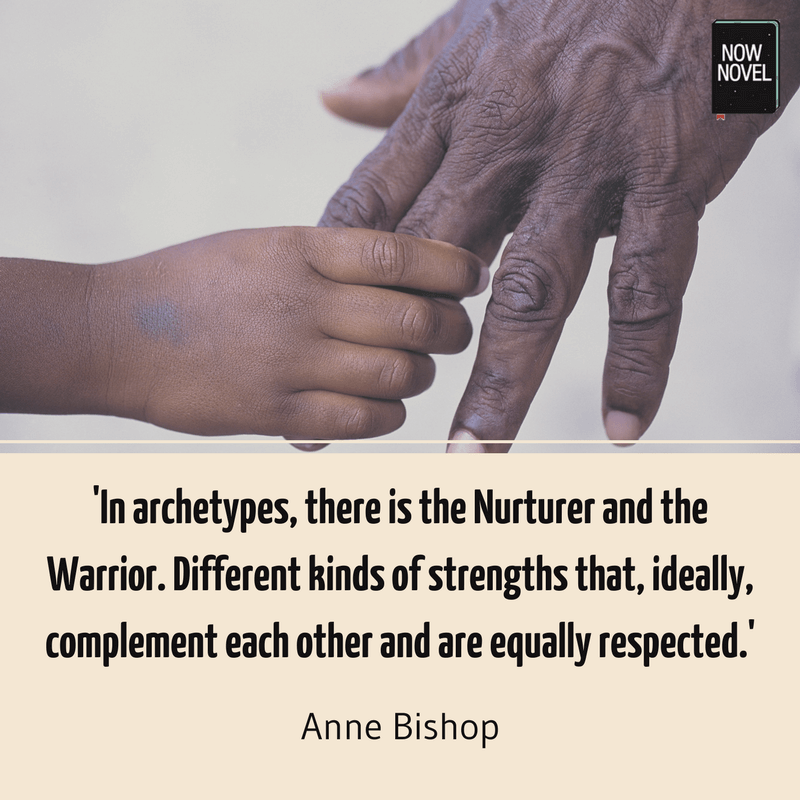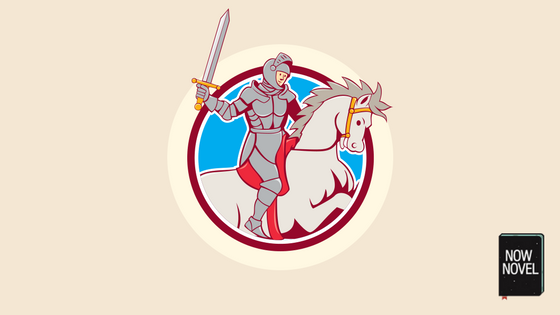Archetypes are useful for imagining diverse, interesting characters. Literature is full of jesters and jokers, lovers, warriors, wise sages, and fools. Some of these are literal (the fool is a literal court jester who entertains a king), others metaphorical (the ‘class clown’ who loves to entertain). Read archetype examples and tips for using this concept to make your characters and their arcs more intriguing:
First, what are archetypes? A fuller definition
The first definition of ‘archetype’ comes from psychology. We’ve written previously about Jungian character archetypes. In Jung’s writing, an archetype is a concept that describes a ‘mental image inherited from the earliest human ancestors’.
For example, when we picture a ‘warrior’, regional, cultural or language differences aside, we are likely to picture someone who is a fighter, a leader; someone whose calling is to fight for kingdom, country, or their own reasons.
Secondly, ‘archetype’ is also used more broadly to mean ‘a very typical example of a certain person or thing’. For example, you could say someone is the ‘archetypal lover’. This means they match our ideas of what ‘lovers’ do (write love letters, perhaps, or pine for the loved object when they are apart).
Thirdly, ‘archetype’ also means ‘an original which has been imitated’ (OED).
Think of archetype examples from stories like the ‘unhappy philosopher’ or the ‘jester’ character archetype.
You see this character from Shakesepeare’s title character in Hamlet (who questions everything) to the jaded Holden Caufield in J.D. Salinger’s wry novella, Catcher in the Rye (1951). Although authors might not be intentionally imitating each other, their work imitates the shared archetype, the broad images that circle back again and again, in new clothes, in many authors’ creations.
See more of our top posts on character types and archetypes at our character writing hub.
Now that we’ve defined archetypes, how do you create unique characters using this concept?
1. List character archetypes that fit your story idea
Certain character archetypes go almost by default with certain kinds of story. The ‘warrior’ archetype makes sense in a historical war novel, for example. In a romance, the lover archetype is an obvious choice.
List archetypes alongside their typical strengths and flaws. For example:
Archetype: Warrior
Strengths: Fearlessness, willingness to serve, raw power
Flaws: Conflict can spill over into other areas of life, emotional detachment or numbing
Archetype: Lover
Strengths: Kindness, Empathy
Flaws: May put others’ needs above their own, vulnerable to deceit or betrayal of trust/vulnerability
Think of other archetypes. As an exercise, write down archetypes such as ‘Jester/Joker’, ‘Mother’, and ‘Villain’. Free-write ideas of what strengths or flaws these types could have.
Think about your story idea. Do any of these characters types fit your story? How could their strengths or flaws affect how it unfolds?
2. Complicate common archetypes
Character archetypes that are used in an obvious and heavy-handed way often feel too stylized, unimaginative or one-dimensional. The warrior who is an out-and-out fighter and lives for the battlefield is still interesting (when you give him goals, stakes, and flaws). Yet a warrior whose character subverts our assumptions about character types is often fascinating.
Subverting character archetypes: An example
In Sebastian Faulks’ war novel Birdsong (1993), the protagonist Stephen Wraysford becomes a lieutenant of the British Army. As we might expect of a ‘warrior’ or ‘fighter’ archetype, while he is stationed in France in 1916 Stephen refuses leave because he’s committed to the war.
Yet we also see Stephen grow lonely, and he writes to a woman he had an affair with pre-war. Stephen confesses his enduring love. A year later, when he temporarily returns to England, he also expresses relief to be away from the trenches.
Here, we might assume the high-ranking army man who refuses to desert the cause is the typical ‘warrior’ archetype. Yet the romantic and emotional aspect of Stephen – his reaching out to a past lover and the relief he finds in ‘home’ – makes him something of a reluctant warrior, too.
There is tension in the character between the ‘warrior’ and ‘lover’ archetypes. What you could call ‘archetypal tension’ makes the character human, multi-faceted.
These tensions within Stephen add uncertainty and intrigue to the story. Mixing archetypal qualities this way is one way to make characters more interesting.

3. Combine opposite character archetypes for conflict or humour
Combining contradicting or contrasting archetypes is often explosive. What happens, for example, when an archetypal ‘warrior’ has a friend, romantic interest or travelling companion who fits the ‘lover’ archetype?
A great example of combining character types comes from one of the oldest known novels – Don Quixote (1615) by Miguel de Cervantes.
In Don Quixote, the main character, a man approaching 50, decides to wear a suit of armour and reinvent himself as a knight. He even reimagines his poor, exhausted horse as a noble steed he names ‘Rocinante’. Believing the romance books he’s read to be true, he goes on wild adventures, accompanied by his neighbour Sancho Panza, a simple farmer.
The absurdity of the contrast between these main characters gives the book its comical delight. We see events through very different archetypal characters’ eyes. Don Quixote, the classic ‘Fool’, deep in his own fantasy world, attacks windmills (claiming they’re giants). Sancho Panza, his practical, down-to-earth sidekick, details the bewildering, crazy events he witnesses.
When you brainstorm details about your characters, think of conflicting archetypal qualities. How does the straight-laced, by-the-book character react to the constant fool? Do they humour them, as Sancho humours the Don, or is it a recipe for major conflict?
4. Develop characters beyond archetype tropes
A ‘trope’ in art and literature is ‘a significant or recurring motif or theme’ (OED). For example, fantasy and adventure novels are full of the ‘orphan’ character whose special mission it is to defeat a great evil.
Tropes like these are risky to use because they can feel unoriginal if obvious and heavy-handed. Develop the archetypal elements of your characters – their warriorlike or other qualities – to avoid this.
J.K. Rowling’s Harry Potter is perhaps the most familiar Orphan archetype in fiction from the past 50 years. Even though Harry’s parents are deceased, however, Rowling takes care to develop this aspect of the character.
Harry’s orphaned state is not simply a ‘trope for trope’s sake’. Rowling could have used this trope simply as backstory to make the reader feel empathy for Harry. Or as the source of the emotion (anger) increasing his motivation to bring down the series’ villain.
Yet Rowling develops this idea of the loss of family further. We see the troubled relationship Harry has with his abusive surrogate family (his aunt and uncle). We meet the second family he finds in his magic school – his chosen family – in the kinder authority figures he finds there. Rowling thus develops her character beyond his starting orphaned state, showing different kinds of family that worsen or ease the loneliness of familial loss as Harry’s arc develops.
This development helps the ‘orphan hero’ archetype not dominate the story and draw attention to itself as a trope. The archetypal backstory is mainly in the background, the facts of it simply underlying Harry’s motivations and goals.

5. Include characters who change from one type to another
Many archetype examples show a person changing from one primary trait or quality to another. In a story where a tough gangster finds an abandoned child and has to take care of them, for example, we might see a transformation from ‘warrior’ to ‘guardian’.
These are of course terms that easily oversimplify. However, thinking of characters in terms of archetypes and change helps us keep characters dynamic.
Sometimes characters are fascinating, funny or charming in how completely predictable and dependable they are in their words and deeds. Yet even if your main character is a little more static in their personality and goal, you can still have secondary characters who add change, uncertainty and intrigue.
Classic archetype examples from books where characters change:
- Pragmatist to Madman (Jack Torrance in Stephen King’s The Shining. Hotel caretaker becomes deranged.)
- Warrior to Lover (Stephen Wraysford in Sebastian Faulks’ Birdsong. Military man seeks intimacy, relief from conflict.)
- Child to Sage/Wise Person (Pip in Charles Dickens’ Great Expectations. Child discovers the truth of his inherited fortunes.)
Complete transformation in a character from one archetype to another isn’t required, of course. Yet if you want to create a dramatic, bold character arc, it’s a useful. Because change is the lifeblood of story.
Get help developing whatever type of character you’re working on – join Now Novel to get comprehensive story brainstorming tools and constructive critiques.


One reply on “Archetype examples: Write great characters from universals”
Four and five are the money, here. Thanks for sharing.